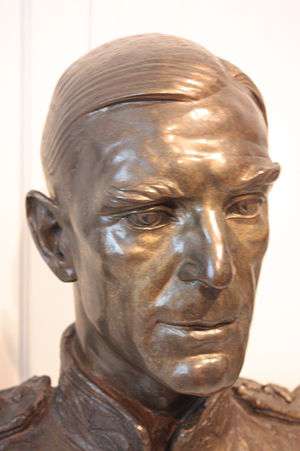Charles Wheeler (sculptor)
- For others with the same name see Charles Wheeler (disambiguation)
| Sir Charles Wheeler | |
|---|---|
 Bank of England facade, sculpture by Sir Charles Wheeler | |
| Born |
Charles Thomas Wheeler 14 March 1892 Codsall, Staffordshire, England |
| Died |
22 August 1974 (aged 82) Five Ashes, Mayfield, Sussex, England |
| Education | |
| Known for | sculpture, architectural sculpture |
| Awards | |
Sir Charles Thomas Wheeler KCVO CBE PRA (14 March 1892 – 22 August 1974) was a British sculptor who worked in bronze and stone who became the first sculptor to hold the Presidency of the Royal Academy, from 1956 through 1966.[1]
Biography

Wheeler was the son of a journalist and was born in Codsall, Staffordshire and raised in nearby Wolverhampton. He studied at the Wolverhampton College of Art, now Wolverhampton University, under Robert Emerson, between 1908 and 1912.[2] In 1912 he won a scholarship to the Royal College of Art where he studied under Édouard Lantéri until 1917.[3] Throughout the remainder of World War I Wheeler was classified as unfit for active service and instead modelled artificial limbs for war amputees.
Wheeler came to specialize in portraits and architectural sculpture. From 1914 until 1970 he exhibited regularly at the Royal Academy and became a Fellow of the Academy in 1940 and became its President in 1956. His tenure as RA president was controversial for the decision by the Academy to sell the most valuable painting in its collection, the Leonardo da Vinci cartoon of the The Virgin and Child with St Anne and St John the Baptist. The possibility that the painting might leave Britain caused a public outcry and eventually it was sold to the National Gallery.[4] From 1942 to 1949, he served as a Trustee of the Tate Gallery and in 1946 was a member of the Royal Fine Art Commission.[5] In 1968 he wrote his autobiography, High Relief.
During the Second World War Wheeler was the only sculptor to be given full-time contracts by the War Artists' Advisory Committee. In both 1941 and 1942, Wheeler was commissioned to produce portrait busts of Admiralty figures. Due to material shortages and other issues, Wheeler only produced three bronze figures during the commission period.[6][7]
Works
Notable works include by Wheeler include,[8]
- The 20-foot bronze doors and a major program of sculptures, including the "Lothbury Ladies" and the gilded finial figure of Ariel for the Bank of England, with architect Sir Herbert Baker, 1922–45
- Fountain and memorial plates for Blackmoor Cloisters (War Memorial) by Sir Herbert Baker.
- Sculptures for Rhodes House, Oxford, with Baker, 1927
- Sculptures for India House, Aldwych, with Baker, 1928–30
- Sculptures for South Africa House with Baker, 1934
- The western fountain figures in Trafalgar Square, 1948
- The allegorical figures of the Seven Seas at the Tower Hill Memorial
- The statue of Lady Wulfrun outside St. Peter's Collegiate Church, Wolverhampton
- The monumental Earth and Water figures for the Ministry of Defence in Whitehall
References
- ↑ "Charles Wheeler, P.R.A.". Royal Academy. Retrieved 16 October 2016.
- ↑ "Wolverhampton's Blue Plaques". Retrieved 16 October 2016.
- ↑ Frances Spalding (1990). 20th Century Painters and Sculptors. Antique Collectors' Club. ISBN 1 85149 106 6.
- ↑ Ian Chilvers (2004). The Oxford Dictionary of Art. Oxford University Press. ISBN 0 19 860476 9.
- ↑ "Artist biography, Sir Charles Wheeler". Tate. 2004. Retrieved 16 October 2016.
- ↑ Brain Foss (2007). War Paint: Art, War, State and Identity in Britain, 1939-1945. Yale University Press. ISBN 978-0-300-10890-3.
- ↑ Imperial War Museum. "War artists archive, Charles Wheeler". Imperial War Museum. Retrieved 16 October 2016.
- ↑ University of Glasgow History of Art (2011). "Sir Charles Thomas Wheeler PRA, KCVO, CBE". Mapping the Practice & Profession of Sculpture in Britain & Ireland 1851-1951. Retrieved 16 October 2016.
External links
| Wikimedia Commons has media related to Charles Wheeler (sculptor). |
| Cultural offices | ||
|---|---|---|
| Preceded by Sir Albert Richardson |
President of the Royal Academy 1956–1966 |
Succeeded by Walter Thomas Monnington |